Merlyn Thomas, Mat Murphy & Peter MWAITry the BBC
 BBC
BBCWarning: This story contains graphic descriptions of murders.
The fighters laughed as they climbed into the back of a pick-up truck, sped past a row of nine dead bodies and drove towards the Setting Sudanese Sun.
“Look at all this work. Look at this genocide,” one cheers.
He smiled as he turned the camera back to himself and his fellow fighters, their rapid support force (RSF) showing: “They’re all going to die like this.”
The men celebrated a massacre that scared human rights officials that killed more than 2,000 people in the Sudanese city of El-Faster last month. On Monday, the International Criminal Court (ICC) said it was investigating whether the paramilitaries could have crimes against humanity and crimes against humanity.
El-Fasther is a key target for the paramilitary RSF. This is the last stronghold in Darfur held by the Sudanese military – where the RSF has been fighting a devastating war since Their ruling coalition collapsed in 2023.
More than 150,000 people are estimated to have been killed in the fighting over the past two years and both sides have been accused of a spate of war crimes – many of which the RSF repeated after the fall of El-Faster.
A city is cut off from the world
Taking the city under siege for almost two years, from August the RSF moved to relocate its position and blocked the rest of the civilian population.
Satellite images show that the troops began to build a large bermier – a raised sand dune – around the perimeter of El-Fasters, spectating access routes and access routes. In early October the ring completely surrounded the town – with a small barricade surrounding a neighboring village.
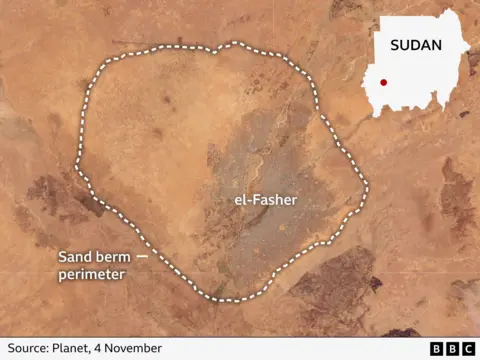
As the siege intensified, 78 people were killed in one RSF attack on a mosque on 19 Septemberwhile the UN said 53 more were killed in a drone and artillery attack on a displacement camp in October.
Videos shared by the BBC’s VYCify also suggest that RSF intends to impose a blockade on food and essential goods. In October, footage showed a man with his hands and feet behind him, hanging from a tree with metal chains with metal chains with metal chains with metal chains with metal chains with metal chains with metal chains with metal chains with metal chains with metal chains. The man filming the video accused him of trying to smuggle supplies into the besieged city.
“I swear to God you will pay for you dog,” he shouted, before demanding that the hostage beg for his life.
Meanwhile, the RSF pushed into the city with troops engaging in frenetic Street-to-Street Clashes.
The graphic footage shows unarmed people being shot
At sunrise on 26 October the RSF overran the last army positions and captured the city’s main base, the headquarters of the 6th Infantry Division, the military said.
Soldiers are parked laughing as they travel through abandoned trees carrying a grenade launcher. Later that day RSF Commander Abdul Rahim Dagalo – Brother of RSF Chief Mohammad ‘Hemedti’ Dagalo – was seen inspecting the base.
The rsf – that emerged from the Janjaweed militia That killed hundreds of thousands of people in Darfur between 2003-2005 – long accused of atrocities against non-Arab groups in Sudan. Footage posted online suggests that paramilitary fighters intend to unleash violence against the civilian population of El-Faster.
Before the paramilitary takeover of El-Fasher, Very little information has emerged out of town for months. But within hours of the military collapse, footage of atrocities committed by the RSF began appearing online, shattering the silence that fell on the city.
One of the most graphic videos to emerge and analyzed by VPC Verify shows the aftermath of a massacre in a university building in the west of the dead.
An old man dressed in white sat alone among the bodies. He turned to see a soldier armed with a rifle walking up the stairs towards him. Raising his weapon, the gunman fired a shot at the man, who collapsed on the floor motionless. The fellow soldiers, who could not be trusted in the act, immediately found a man’s foot spinning in the tangle of bodies.
“Why is it still alive,” one defender cried. “Shoot him.”
Satellite images taken on 26 October appear to confirm that the killings were also carried out in the streets of El-Flasher, according to a report published by the Benitarian Research lab.
Its analysts highlighted the many “clusters” seen in the images, which they said were “consistent with the size of adult bodies and were not present in previous imaging”. It also pointed to the “dissociation” that the report said turned out to be marks caused by human blood.
An eyewitness who spoke to the BBC said he witnessed “many of our relatives being killed – they were rounded up in one place and everyone was killed”.
Another Witness recalled seeing a woman killed after the RSF shot her “in the chest” before dumping her body “after taking all her possessions”.
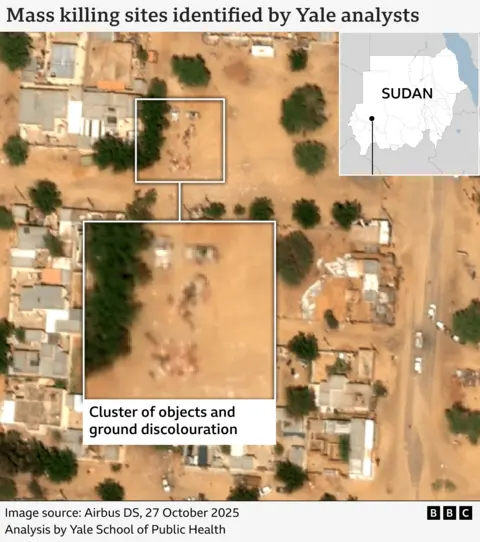
While the main force of the RSF in El-Faster, a separate group of fighters remained in the periphery of the town, where they participated in the brutal execution of many unarmed people.
Most of this violence took place at a site about 8km (5 miles) away from El-Faster. Confirmed videos that show many dead bodies in civilian clothes – some of which are women with a trench run in the interior of the BRMF.
Other clips show scenes of destruction, with fires burning and the burnt shells of trucks dotted across the scene. Videos from the scene also show bodies scattered between vehicles.
A significant violence figure previously identified by BBC Verify as a RSF Commander to go to Abu Lulu online. He was shown executing unarmed hostages in two videos, while an eyewitness told the BBC that he “ordered his men to kill many innocent people, including children”.
One clip shows an RSF soldier trying to intervene as Abu Lulu prepares to kill a wounded man, while the captive pleads with you. “
Abu Lulu left the man’s pleas with a wave of his arms, saying: “I have no mercy. Our work only kills.” After aiming his rifle almost casually, the fighter fired a storm of bullets that tore through the unarmed man.
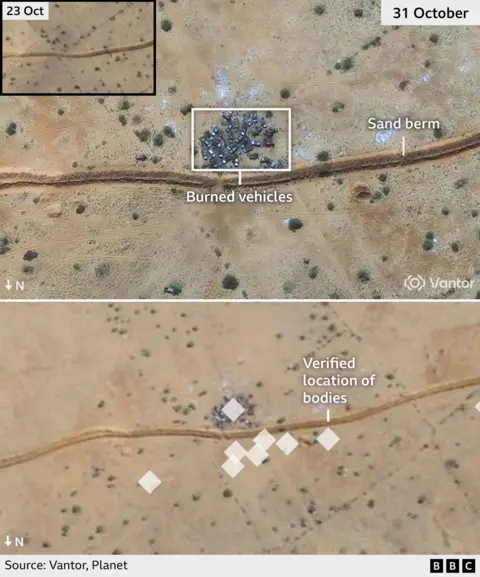
Another video shows him killing a group of nine unarmed captives. Footage that emerged days later revealed the bodies left where they had fallen – still lined up execution-style and lying on the dusty Darfuri ground.
Many of those involved in the killings wore RSF badges, including the group that later celebrated the massacre as a “genocide”.
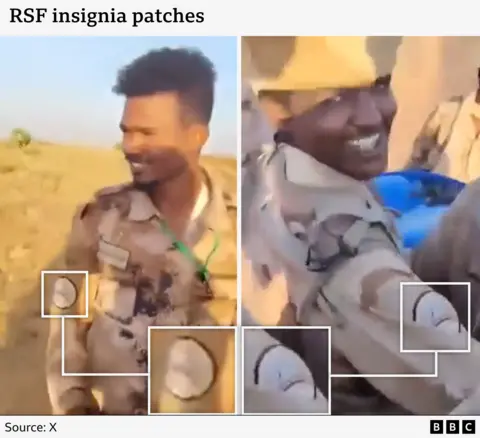
RSF commanders sought to bring about damage control
In the days following the massacre, RSF leader Gendan Dagalo admitted that his troops had committed “violations” and said the incidents would be investigated. A senior official said last week that the RSF had announced that they had arrested some suspects in their ranks.
Among those Abu Lulu was captured After verification the BBC published a report documenting his murder. Carefully choreographed and edited footage posted on the official RSF telegram account shows him being led to a prison cell by el-fasters.
The Yale Analyst also accused RSF of “conducting a purge of their alleged mass atrocities”. A report issued on 4 November found that satellite images showed the removal of objects consistent with bodies from the graves of children in Ersf
The BBC identified the white objects seen in the hospital grounds on 30 October as being between 1.6m and 2m long. It is about the height of an adult man and is consistent with a body in a grave commonly seen in Sudan.

Meanwhile, RSF and associated narratives on social media began seeking to reframe the narrative.
Posts showing fighters helping civilians were shared by some users, while the paramilitary media office shared several clips of the army’s treatment of prisoners.
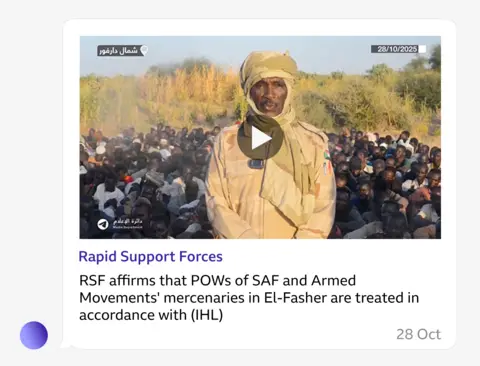
Despite the social media campaign deployed by RSF, their actions in El-Fasther fueled global outrage.
VBC Pertifiahon approached the RSF, offering an opportunity to respond to the allegations contained in this investigation. The group did not respond.
Additional reporting by Kevin Nguyen, Kumar Malhotra, Richard Irvine-Brown, Alex Murray, Barbara Metzler, Lamees Altalebi and Ahmed Nour. Graphics by Jess Carr and Mesut Ersoz.



